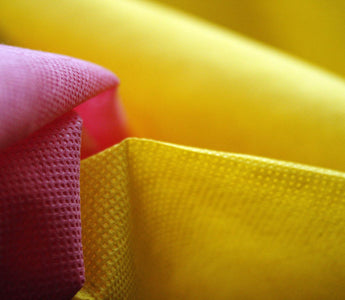The differences between the various materials used in disposables
When talking about disposables it is easy to come across different materials such as tnt, plp, sponge and others. We will try to clarify the differences and the most appropriate uses of each material. Depending on the technical characteristics, each material can be more or less suitable for the intended use.
So I advise you to take note of the technical characteristics of each material so you can choose the best product for your needs.
TNT : or Non-Woven Fabric, is the generic term to indicate an industrial product similar to a fabric, but obtained with processes other than weaving. The main characteristics are resistance to both low and high temperatures , water repellency , the ability to provide a barrier for bacteriological agents and the softness of the fabric, therefore not abrasive to the touch.
The TNT is made up of a veil of fibers distributed directionally in a pre-established way and then cohesionated with mechanical, chemical or physical methods, or by the combination of these different procedures without considering classic spinning.
PLP OR CARTENE : Polypropylene is also referred to as PLP or Cartene, it is a resistant and rigid thermoplastic, semi-crystalline material and melts at a higher temperature.
Polypropylene has high resistance characteristics to chemical agents in the presence of aqueous solutions containing salts, acids and strong alkalis. They also have an effective biological barrier effect allowing for optimal air exchange, making them ideal for protective clothing . Polypropylene is a synthetic plastic material, obtained from petroleum fractions.
It is very suitable for recycling and therefore perfect for single use and is an extremely versatile material with water-repellent properties . Polypropylene can also be produced into fiber by passing the molten polymer through tiny nozzles.
These fibers find application in the textile industry, for the creation of velvety carpets, outdoor upholstery and curtains, blankets, underwear and technical-sports clothing.
TNT+PLP : when you combine TNT with PLP you obtain a material that is absorbent on one side and waterproof on the other. It cannot be sterilized in an autoclave but with ethylene oxide.
If this material is to be used for clothing, a process is carried out which gives the material the characteristic of being able to filter the air, otherwise annoying temperature changes would occur. Thanks to this process the fabric remains soft, comfortable and breathable.
SPUNLACE : Spunlace is a non-woven fabric with isotropic properties that give the material equidirectional strength .
It has many properties, such as the possibility of being produced in different materials (viscose, polyester, cotton, polyamide and microfibre), the two possible finishes (smooth or perforated) and the multitude of colors with which it can be shaped and suitable for printing.
Spunlace is a non-woven fabric that derives from a process that consists of consolidating the veil using high-pressure water jets that pierce the fabric and intertwine the fibers. The main characteristics are resistance , absorption , hypoallergenic and therefore non-irritating capacity .
SPONGE : the sponge is an artificial fiber extracted from vegetable cellulose; a textile fiber that uses a part of raw material of natural origin and a part of synthetic chemical substances, and is obtained through various chemical processes in the laboratory.
The sponge is a highly breathable fabric that gives a touch of freshness to our body, being an artificial fiber of natural origin it has moisture absorption properties in greater quantities than any synthetic textile fibre.
By preventing the formation of bacteria and the growth of dust mites, the fabric can often be classified as hypoallergenic and thanks to this hypoallergenic property it is also used to make bedspreads and towels, and clothing.
CELLULOSE : cellulose is one of the most important polysaccharides. It consists of a large number of glucose molecules joined together by a glycosidic bond. It is mainly contained in vegetables.
It has a great absorbent capacity and does not contain plastic materials but is composed of cellulose fibers worked with air. The advanced techniques with which it is treated allow a result very similar to fabric .
Disposable items are an indispensable element in beauty centers and spas both for reasons of hygiene and the safety of operators and customers. Diroestetica supplies various products made up of disposable fabrics , this guide serves to clarify the various types and conformations of each individual material so that you can choose the one best suited to your needs.



